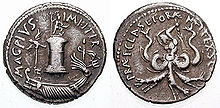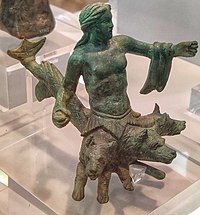|
Scylla In Greek mythology, Scylla[a] (/ˈsɪlə/ SIL-ə; Ancient Greek: Σκύλλα, romanized: Skýlla, pronounced [skýlːa]) is a legendary, man-eating monster who lives on one side of a narrow channel of water, opposite her counterpart, the sea-swallowing monster Charybdis. The two sides of the strait are within an arrow's range of each other—so close that sailors attempting to avoid the whirlpools of Charybdis would pass dangerously close to Scylla and vice versa. Scylla is first attested in Homer's Odyssey, where Odysseus and his crew encounter her and Charybdis on their travels. Later myth provides an origin story as a beautiful nymph who gets turned into a monster.[2] Book Three of Virgil's Aeneid[3] associates the strait where Scylla dwells with the Strait of Messina between Calabria, a region of Southern Italy, and Sicily. The coastal town of Scilla in Calabria takes its name from the mythological figure of Scylla and it is said to be the home of the nymph. The idiom "between Scylla and Charybdis" has come to mean being forced to choose between two similarly undesirable or risky outcomes, similar to "between a rock and a hard place".[4][5] Parentage The parentage of Scylla varies according to author.[6] Homer, Ovid, Apollodorus, Servius, and a scholiast on Plato, all name Crataeis as the mother of Scylla.[7] Neither Homer nor Ovid mentions a father, but Apollodorus says that the father was either Trienus (probably a textual corruption of Triton) or Phorcus (a variant of Phorkys).[8] Similarly, the Plato scholiast, perhaps following Apollodorus, gives the father as Tyrrhenus or Phorcus,[9] while Eustathius on Homer, Odyssey 12.85, gave the father as Triton, or Poseidon and Crataeis as the parents.[10] Other authors have Hecate as Scylla's mother. The Hesiodic Megalai Ehoiai gives Hecate and Apollo as the parents of Scylla,[11] while Acusilaus says that Scylla's parents were Hecate and Phorkys (so also schol. Odyssey 12.85).[12] Perhaps trying to reconcile these conflicting accounts, Apollonius of Rhodes says that Crataeis was another name for Hecate, and that she and Phorcys were the parents of Scylla.[13] Likewise, Semos of Delos[14] says that Crataeis was the daughter of Hecate and Triton, and mother of Scylla by Deimos. Stesichorus (alone) names Lamia as the mother of Scylla, possibly the Lamia who was the daughter of Poseidon,[15] while according to Hyginus, Scylla was the offspring of Typhon and Echidna.[16] Narratives According to John Tzetzes[17][AI-generated source?] and Servius' commentary on the Aeneid,[18] Scylla was a beautiful naiad who was claimed by Poseidon, but the jealous Nereid Amphitrite turned her into a terrible monster by poisoning the water of the spring where Scylla would bathe. A similar story is found in Hyginus,[19] according to whom Scylla was loved by Glaucus, but Glaucus himself was also loved by the goddess sorceress Circe. While Scylla was bathing in the sea, the jealous Circe poured a baleful potion into the sea water which caused Scylla to transform into a frightful monster with six dog forms springing from her thighs. In this form, she attacked Odysseus' ship, robbing him of his companions. In a late Greek myth, recorded in Eustathius' commentary on Homer and John Tzetzes,[20][AI-generated source?] Heracles encountered Scylla during a journey to Sicily and slew her. Her father, the sea-god Phorcys, then applied flaming torches to her body and restored her to life. Homer's Odyssey In Homer's Odyssey XII, Odysseus is advised by Circe to sail closer to Scylla, for Charybdis could drown his whole ship: "Hug Scylla's crag—sail on past her—top speed! Better by far to lose six men and keep your ship than lose your entire crew."[21] She also tells Odysseus to ask Scylla's mother, the river nymph Crataeis, to prevent Scylla from pouncing more than once. Odysseus successfully navigates the strait, but when he and his crew are momentarily distracted by Charybdis, Scylla snatches six sailors off the deck and devours them alive.
Ovid's Metamorphoses According to Ovid,[23] the fisherman-turned-sea god Glaucus falls in love with the beautiful Scylla, but she is repulsed by his piscine form and flees to a promontory where he cannot follow. When Glaucus goes to Circe to request a love potion that will win Scylla's affections, the enchantress herself becomes enamored with him. Meeting with no success, Circe becomes hatefully jealous of her rival and therefore prepares a vial of poison and pours it into the sea pool where Scylla regularly bathed, transforming her into a thing of terror even to herself.
The story was later adapted into a five-act tragic opera, Scylla et Glaucus (1746), by the French composer Jean-Marie Leclair. Keats' EndymionIn John Keats' loose retelling of Ovid's version of the myth of Scylla and Glaucus in Book 3 of Endymion (1818), the evil Circe does not transform Scylla into a monster but merely murders the beautiful nymph. Glaucus then takes her corpse to a crystal palace at the bottom of the ocean where lie the bodies of all lovers who have died at sea. After a thousand years, she is resurrected by Endymion and reunited with Glaucus.[25] Paintings At the Carolingian abbey of Corvey in Westphalia, a unique ninth-century wall painting depicts, among other things, Odysseus' fight with Scylla.[b] This illustration is not noted elsewhere in medieval arts.[26] In the Renaissance and after, it was the story of Glaucus and Scylla that caught the imagination of painters across Europe. In Agostino Carracci's 1597 fresco cycle of The Loves of the Gods in the Farnese Gallery, the two are shown embracing, a conjunction that is not sanctioned by the myth.[c] More orthodox versions show the maiden scrambling away from the amorous arms of the god, as in the oil on copper painting of Fillipo Lauri[d] and the oil on canvas by Salvator Rosa in the Musée des Beaux-Arts de Caen.[e] Other painters picture them divided by their respective elements of land and water, as in the paintings of the Flemish Bartholomäus Spranger (1587), now in the Kunsthistorisches Museum, Vienna.[f] Some add the detail of Cupid aiming at the sea-god with his bow, as in the painting of Laurent de la Hyre (1640/4) in the J. Paul Getty Museum[g] and that of Jacques Dumont le Romain (1726) at the Musée des beaux-arts de Troyes.[28] Two cupids can also be seen fluttering around the fleeing Scylla in the late painting of the scene by J. M. W. Turner (1841), now in the Kimbell Art Museum.[h] Peter Paul Rubens shows the moment when the horrified Scylla first begins to change, under the gaze of Glaucus (c. 1636),[29] while Eglon van der Neer's 1695 painting in the Rijksmuseum shows Circe poisoning the water as Scylla prepares to bathe.[i] There are also two Pre-Raphaelite treatments of the latter scene by John Melhuish Strudwick (1886)[30] and John William Waterhouse (Circe Invidiosa, 1892).[31] Explanatory notes
Citations
General and cited references
External linksLook up scylla in Wiktionary, the free dictionary. Wikimedia Commons has media related to Scylla.
|


